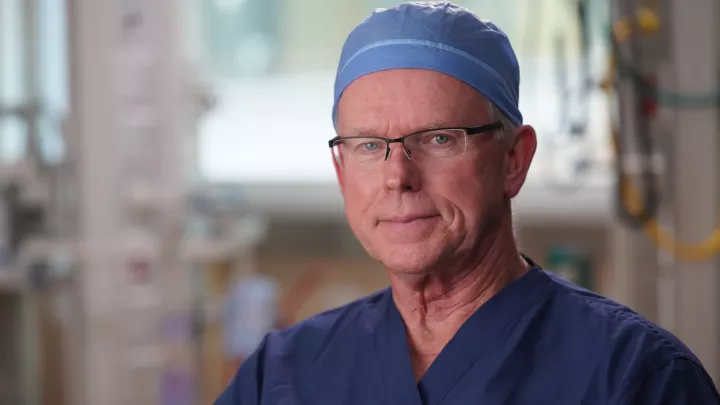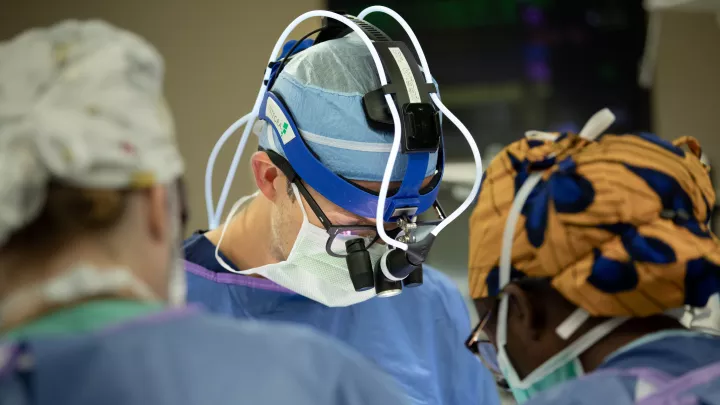
Vaughn Starnes, MD, in the operating room
Ross Procedure Outcomes in Children Tied to Anatomy
The Ross procedure—which uses a child’s healthy pulmonary valve to replace a diseased aortic valve—has been shown to have excellent outcomes in pediatric patients overall. But how does a patient’s age and heart anatomy impact the surgery’s success?
To answer this question, a team at Children’s Hospital Los Angeles recently conducted a 30-year study of more than 300 pediatric patients who underwent the Ross at CHLA. The study—the largest pediatric Ross study of its kind at a single center—examined outcomes not only by patients’ age, but also by the complexity of their congenital heart disease.
“What we found is that the risk is higher in neonates and infants, but that is because those patients have a higher rate of more complex heart defects,” says Markian Bojko, MD, a USC surgical resident and author of the study. “The higher risk is a result of those other pathologies, not the Ross procedure itself.”
Dr. Bojko presented the findings at the American Association for Thoracic Surgery Annual Meeting, held April 27-30 in Toronto. Vaughn Starnes, MD, Chief of Cardiovascular Surgery and Co-Director of the Heart Institute at Children’s Hospital Los Angeles, was the study’s senior author.
Why the Ross?
Children’s Hospital Los Angeles is one of just a handful of pediatric centers in the country with expertise in performing the Ross procedure, and Dr. Starnes is a world leader in this complex surgery.
Because the Ross uses the child’s own valve, that valve then grows with the child instead of needing multiple replacements. Long-term survival rates for children with a Ross also match the general population—something that is not true for those who receive mechanical valves. In addition, patients do not have to be on lifelong blood thinner therapy.
“Being on blood thinners is difficult for kids,” says Dr. Starnes, the H. Russell Smith Foundation Chair in Cardiothoracic Surgery. “They can’t go to the playground; they can’t play sports like soccer or baseball. But children with a Ross procedure can do all of those things. It gives them back their childhood.”
Still, there has been a perception that the technically demanding operation is too risky in younger patients—specifically neonates (younger than 30 days) and infants under 1 year.
Key findings
In the study, the team looked at all pediatric patients, from birth to 18 years of age, who underwent the Ross at CHLA since 1992. The study, which included 317 patients, found that:
- The procedure had outstanding outcomes for pediatric patients of all ages—including neonates—who had isolated aortic valve disease.
- Among 29 infants and neonates with isolated aortic valve disease, the average length of hospital stay was just seven days, with no major complications and only one operative mortality.
- The younger the baby was at the time of the Ross, the more likely the baby was to have more complex heart defects.
- Neonates and infants with complex disease—such as Shone’s complex, interrupted aortic arch, mitral valve disease or subvalvular stenosis—had the highest rates of perioperative mortality and morbidity.
“What we found is that it’s these more complex defects that raise the risk, often because these babies need a second major surgery at the same time as the Ross,” Dr. Bojko explains. “But when the disease was isolated, even the youngest patients did very well.”
Managing high-risk babies
The research builds on the results of a 2021 study, led by John Cleveland, MD, at CHLA, which showed that the Ross had excellent long-term durability for infants and neonates.
That study also found that more complex disease—especially Shone’s complex and interrupted aortic arch with ventricular septal defect—significantly increased the risk of poor outcomes for these youngest patients.
Based on those results—confirmed by this latest research—the CHLA team often takes a single-ventricle approach for these high-risk babies.
“Doing a Norwood for babies with Shone’s complex allows those babies and their heart structures to grow for a year or two,” Dr. Starnes says. “Then we can go back and take down the Norwood and do a Ross procedure at that later time. That significantly lowers the risk.
“But for many other young patients who need an aortic valve, the Ross remains the best option,” he adds. “It’s becoming the operation of choice for young adults and children.”
Study authors were Markian Bojko, Luke Wiggins, John Cleveland, Ramsey Elsayed, David Cleveland and Vaughn Starnes.


